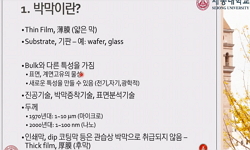Si_(1-x)Mn_(x) semiconductor thin films were grown on (100)Si wafer by using molecular beam epitaxy and their magnetic properties were studied. Native oxide layer on (100)Si wafer was not removed intentionally in order to provide enough nucleation sit...
http://chineseinput.net/에서 pinyin(병음)방식으로 중국어를 변환할 수 있습니다.
변환된 중국어를 복사하여 사용하시면 됩니다.
- 中文 을 입력하시려면 zhongwen을 입력하시고 space를누르시면됩니다.
- 北京 을 입력하시려면 beijing을 입력하시고 space를 누르시면 됩니다.
MBE로 성장한 다결정 Si_(1-x)Mn_(x) 박막의 전·자기적 특성 연구 = Magneto-electronic properties of polycrystalline Si_(1-x)Mn_(x) semiconductors grown by MBE
한글로보기https://www.riss.kr/link?id=T9407820
- 저자
-
발행사항
대전 : 忠南大學校 大學院, 2003
-
학위논문사항
학위논문(석사) -- 충남대학교 대학원 , 재료공학과 재료공학전공 , 2004. 2
-
발행연도
2003
-
작성언어
한국어
- 주제어
-
KDC
530.4 판사항(4)
-
발행국(도시)
대전
-
형태사항
viii, 87p. : 삽도 ; 26cm .
-
일반주기명
참고문헌: p. 85
-
소장기관
-
0
상세조회 -
0
다운로드
부가정보
다국어 초록 (Multilingual Abstract)
Si_(1-x)Mn_(x) semiconductor thin films were grown on (100)Si wafer by using molecular beam epitaxy and their magnetic properties were studied. Native oxide layer on (100)Si wafer was not removed intentionally in order to provide enough nucleation sites for various phases appeared in Si-Mn phase diagram. The Si_(1-x)Mn_(x)/SiO_(2)/(100)Si films were grown at the rate of 100Å~200Å/min and final thickness of the films was 3,000Å ~ 10,000Å. Substrate temperature was fixed to 300℃, 400℃. Mn concentration was changed by controlling the flux ratio of Mn and Si. The composition of Si_(1-x)Mn_(x) films were analyzed by using the energy dispersive x-ray spectrometer. Concentration range of Mn is 10.0at%~76.8at%. Hall effect measurement revealed that the Si_(1-x)Mn_(x) semiconductors have p-type carrier at room temperature and carrier concentration is 10^(19)_ 10^(20)/㎤. The electrical resistivity measured by a standard four-probe method is -10^(-4) ohm·cm, and decreases with Mn concentration. The x-ray diffraction(XRD) observations have been done to identify the ferromagnetic phase of Si_(1-x)Mn_(x) thin films. Magnetization behavior of Si_(1-x)Mn_(x) thin films were measured at room temperature by using vibrating sample magnetometer and ferromagnetic resonance and at low temperature using superconducting quantum interference device(SQUID). Ferromagnetic characteristics are seen clearly at 2K eat substrate temperature. XRD analysis and SQUID characteristics show that two magnetic phases are formed in the Si_(1-x)Mn_(x)(x:0.10 ~ 0.77) semiconductors thin films, ferromagnetic SiMn phase and anti-ferromagnetic Si_(3)Mn_(5) phase
* A thesis submitted to the committee of the Graduate School, Chungnam National University partial fulfillment of the requirement for the degree of Master of Material Engineering in February 2003.
목차 (Table of Contents)
- 목차 = Ⅰ
- 제1장. 서론 = 1
- 제2장. 이론적 배경 = 4
- 2-1. 스핀주입 (Spin injection)소재 = 4
- 2-1-1. 스핀분극(Spin polarization) = 6
- 목차 = Ⅰ
- 제1장. 서론 = 1
- 제2장. 이론적 배경 = 4
- 2-1. 스핀주입 (Spin injection)소재 = 4
- 2-1-1. 스핀분극(Spin polarization) = 6
- 2-1-2. 스핀 주입 (Spin injection) = 7
- 2-1-3. 스핀주입소자(Spin injection device) = 8
- 2-2. 스핀주입용 자성 반도체(DMS) = 10
- 제3장. 실험 방법 = 19
- 3-1. 성장 시스템 = 19
- 3-2. Effusion Cell의 제 작 = 20
- 3-3. MBE(Molecular Beam Epitaxy) = 23
- 3-3-1. 에피성장 기술 = 23
- 3-3-2. MBE System의 특징 = 25
- 3-4. MBE 장치의 구성 = 26
- 3-5. MBE에서의 진공조건 및 분자선 분포 = 27
- 3-6. Si_(1)-(x)_Mn_(x)의 성 장 = 33
- 3-6-1. 시편 준비 = 33
- 3-6-2. 실험 방법 = 34
- 3-6-3. 실험 조건 = 34
- 제4장. 측정 및 분석 = 36
- 4-1. 두께 측정 = 36
- 4-2. 성분 분석 = 42
- 4-3. 전기적 특성 측정( Hall, Electric Resistivity ) = 43
- 4-3-1. 전기 비저항 = 43
- 4-3-2. Hall effect 측정 = 44
- 4-4. 자기적 특성 측정 = 46
- 4-4-1. 자기이력곡선 측정(VSM) = 46
- 4-4-2. 강자성 공명 (FMR) = 47
- 4-4-3. SQUID(Superconducting Quantum Interference Device) = 48
- 4-5. 미세 구조 분석(X-Ray Diffraction) = 48
- 제5장. 결과 및 고찰 = 50
- 5-1. 기판온도 300'C = 50
- 5-1-1. 박막 성장률 = 50
- 5-1-2. 성분 분석 = 56
- 5-1-3. 비저항 측정 = 58
- 5-1-4. 자기적 특성 분석 = 59
- 1) 자기이력곡선(VSM) 측정 = 60
- 2) SQUID 측정 = 61
- 5-1-5. XRD(X-ray diffraction) 분석 = 64
- 5-2. 기판온도 400'C = 65
- 5-2-1. 박막 성장률 = 65
- 5-2-2. 성분 분석 = 71
- 5-2-3. 비저항 측정 = 72
- 5-2-4. H진1 측정 = 74
- 5-2-5. 자기적 특성 분석 = 74
- 1) 자기이력곡선(VSM) 측정 = 74
- 2) 강자성 공명(FMR) 측정 = 75
- 3) SQUID 측정 = 77
- 5-2-6. XRD(X-ray diffraction) 분석 = 82
- 제6장. 결론 = 84
- 참고문헌 = 85
- ABSTRACT = 86











